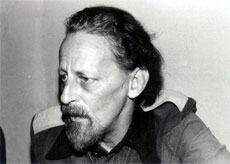More Than Human: An Introduction
Some time in the spring of 1952, living in a little stone house in the woods in Rockland County, New York, I sat down and knocked out yet another story because by that time I knew how to knock out stories. As I recall, I hadn’t a clear idea in my head as to what it was going to be about, except that I had recently read a novel by Pearl Buck called Pavilion of Women, in which there was a minor character, a Chinese monk, who took care of a ragged passel of kids in a cave somewhere in the wilderness. The image would not scrape off, and I knew I was going into something similar somehow. It took about eight days and I sent it off to Horace Gold at Galaxy magazine. He bought it and I paid some rent and bought some furnace oil and hamburger and paper towels and the like for my wives and children, and got to work on something else.
Next thing you know it was October, and the story, called “Baby Is Three,” was in the print, and to my immense and total astonishment began pulling rave mail from all over. Truly, I had an “I didn’t know it was loaded” feeling about the whole thing—not that I felt it was a bad job, but I really had no idea it would hit that hard. Anthology requests began to come in almost immediately here and from England, France, and Latin America. The mail was just lovely.
A year or so later, a book publisher asked me for a novel. The only thing I wanted to write about at that length was something more about where the people in “Baby Is Three” came from, and something more about where they went to. I went to New York and had lunch with some people and we worked out a deal whereby if I wrote 30,000 words of events before “Baby,” and thirty more after, but wrote them in such a way that each could stand as a separate novelette, then they would undertake to sell them to high-paying slick-paper magazines before book publication. (That way, I suspect, they could salve their consciences about the miniscule advance they were willing to pay.) I chuntered around with ideas for a few months, then suddenly sat down and wrote the first part, “The Fabulous Idiot,” and the third part, “Morality,” in about three weeks.
I lugged the two stories in to New York and found that, as is often the practice with publishers, all the people I had dealt with had been fired, transferred, or kicked upstairs, and their replacements didn’t know anything about any handshake agreement to sell the storied to magazines first. They just wrapped up the whole thing and published it as a book.
I teach writing sometimes now, and believe me, I would never advise anyone that the way to sell a successful novel is to write Part Two before Parts One and Three; to construct each part as a separate entity; and to present a finished product scored across like a Hershey bar. “Try that,” I would say, “and you’ll get booted out of their offices, and you’d better pray they threw the manuscript out first so you could land on it.” And for a while I thought something of the sort had happened. The book was announced but never really advertised, and the hardcover house remaindered it nine months after publication. You could get one in used bookstores, brand new, for forty-nine cents. The paperback, co-published at the same time, disappeared pretty rapidly on its first printing; after that it was reissued spasmodically every once in a while for years, during most of which time it couldn’t be found anywhere.
But now the miracle—a slow one, but nevertheless a real miracle. It got an English edition. French. Italian. Spanish, Portuguese. German. One of my greatest joys lies in the simple fact of the publication of four Japanese editions, indicating that what the book had to say (not how prettily it may have been written—that could never had survived translation) was able to cross not only a language barrier but a cultural one, and be read and applauded in the Eastern orientation. With the publication of the Hungarian edition in 1979, More Than Human appears in its eighteenth language.
And that isn’t all. I have at this writing recorded (for Caedmon Records) two of the three sections of the book, and am due to leave for France to make the movie with a fabulous French director and shoot it in Ireland with English-speaking actors. This time it seems for real (though in this business one never knows!); and if it is, it is only the last in a series of eleven options. The weirdest of these involves one of the greatest directors of all time (I won’t tell you his name) and me, who wrote a screenplay and two complete revisions in only twenty-eight days, when all of a sudden the company blew apart and the great man showed up four days later in Rome. I haven’t seen him since.
More Than Human won the International Fantasy Award (the precursor of the Hugo and Nebula Awards in science fiction), and the trophy was presented by the late, great Henry Kuttner. It had caused me grief and joy, lawsuits, and hopes fulfilled and hopes dashed. And now it is off on other new adventures—one of which is its appearance in the new, modern form of the graphic novel, beautifully visualized by Alex Nino—the book you are looking at right now. And I have the feeling it will go on and on for years to come, in other versions, other lands, maybe even other worlds—why not? It says that for humans, there is more beyond, still more beyond that, but growth and change need not alter the basic humanity of humankind or the distinction and worth of every individual.

Theodore Sturgeon

Kit Reed on More Than Human
Read Biography
Theodore Sturgeon—More Than Human: An Introduction
Well received when it was first published in 1953, More Than Human became even more popular as years went by, and in 1978 it was adapted as graphic novel. Sturgeon took the occasion to describe the circumstances in which he wrote the novel.
Theodore Sturgeon
Bonus Material
Audio of Sturgeon reading from More Than Human, on 1950s radio program X Minus One (1956–57), and video of Sturgeon on Tales of Tomorrow (1951).
Other Novels by Theodore Sturgeon





